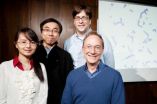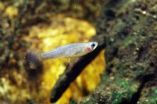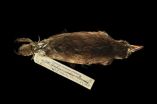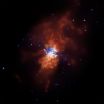(Press-News.org) CHAMPAIGN, Ill. — Researchers at the University of Illinois and Northwestern University have demonstrated bio-inspired structures that self-assemble from simple building blocks: spheres.
The helical "supermolecules" are made of tiny colloid balls instead of atoms or molecules. Similar methods could be used to make new materials with the functionality of complex colloidal molecules. The team will publish its findings in the Jan. 14 issue of the journal Science.
"We can now make a whole new class of smart materials, which opens the door to new functionality that we couldn't imagine before," said Steve Granick, Founder Professor of Engineering at the University of Illinois and a professor of materials science and engineering, chemistry, and physics.
Granick's team developed tiny latex spheres, dubbed "Janus spheres," which attract each other in water on one side, but repel each other on the other side. The dual nature is what gives the spheres their ability to form unusual structures, in a similar way to atoms and molecules.
In pure water, the particles disperse completely because their charged sides repel one another. However, when salt is added to the solution, the salt ions soften the repulsion so the spheres can approach sufficiently closely for their hydrophobic ends to attract. The attraction between those ends draws the spheres together into clusters.
At low salt concentrations, small clusters of only a few particles form. At higher levels, larger clusters form, eventually self-assembling into chains with an intricate helical structure.
"Just like atoms growing into molecules, these particles can grow into supracolloids," Granick said. "Such pathways would be very conventional if we were talking about atoms and molecules reacting with each other chemically, but people haven't realized that particles can behave in this way also."
The team designed spheres with just the right amount of attraction between their hydrophobic halves so that they would stick to one another but still be dynamic enough to allow for motion, rearrangement, and cluster growth.
"The amount of stickiness really does matter a lot. You can end up with something that's disordered, just small clusters, or if the spheres are too sticky, you end up with a globular mess instead of these beautiful structures," said graduate student Jonathan Whitmer, a co-author of the paper.
One of the advantages of the team's supermolecules is that they are large enough to observe in real time using a microscope. The researchers were able to watch the Janus spheres come together and the clusters grow – whether one sphere at a time or by merging with other small clusters – and rearrange into different structural configurations the team calls isomers.
"We design these smart materials to fall into useful shapes that nature wouldn't choose," Granick said.
Surprisingly, theoretical calculations and computer simulations by Erik Luijten, Northwestern University professor of materials science and engineering and of engineering sciences and applied mathematics, and Whitmer, a student in his group, showed that the most common helical structures are not the most energetically favorable. Rather, the spheres come together in a way that is the most kinetically favorable – that is, the first good fit that they encounter.
Next, the researchers hope to continue to explore the colloid properties with a view toward engineering more unnatural structures. Janus particles of differing sizes or shapes could open the door to building other supermolecules and to greater control over their formation.
"These particular particles have preferred structures, but now that we realize the general mechanism, we can apply it to other systems – smaller particles, different interactions – and try to engineer clusters that switch in shape," Granick said.
INFORMATION:
The team also included University of Illinois graduate students Qian Chen and Shan Jiang and research scientist Sung Chul Bae. The U.S. Department of Energy and the National Science Foundation supported this work.
END EMBARGO FOR RELEASE UNTIL 1 P.M. CST THURSDAY (JAN. 13)
Self-assembling structures open door to new class of materials
2011-01-14
ELSE PRESS RELEASES FROM THIS DATE:
More than 31 freshwater species have 'moved' to Galicia over past century
2011-01-14
Galician researchers have studied the evolution in the introduction of non-native fresh water species in Galicia over the past century, and have compared this with the rest of the Iberian Peninsula. The results show that 31 exotic aquatic species out of the 88 recorded for the entire Iberian Peninsula have become established in the region over the past century.
An analysis of the introduction of non-native species in Galicia and the Iberian Peninsula carried out by researchers from the University of Santiago de Compostela (USC) and the University of Coruña (UDC) has shown ...
Scientists sequence gut microbes of premature infant
2011-01-14
Scientists have for the first time sequenced and reconstructed the genomes of most of the microbes in the gut of a premature newborn and documented how the microbe populations changed over time.
Further studies involving more infants could eventually help researchers understand the causes of various intestinal problems that afflict preemies, in particular the sometimes fatal necrotizing enterocolitis, according to researchers at the University of California, Berkeley, the University of Pittsburgh School of Medicine and Stanford University. One unresolved question is whether ...
MIT neuroscientists explain 'Proustian effect' of small details attached to big memories
2011-01-14
CAMBRIDGE, Mass. – Neuroscientists at MIT's Picower Institute of Learning and Memory have uncovered why relatively minor details of an episode are sometimes inexplicably linked to long-term memories. The work is slated to appear in the Jan. 13 issue of Neuron.
"Our finding explains, at least partially, why seemingly irrelevant information like the color of the shirt of an important person is remembered as vividly as more significant information such as the person's impressive remark when you recall an episode of meeting this person," said co-author Susumu Tonegawa, Picower ...
Breaking point: LSU professor discovers method to determine when metals reach end of life
2011-01-14
BATON ROUGE – We live in a world almost completely dependent upon machinery. Since the creation of the simple wheel, humans have found ways to increase quality of life and advance scientific knowledge using these devices. Though the prevalence of machinery has allowed us to build bigger, travel faster and create more quickly with complexity increasing as science advances, our dependence upon them has limitations. Everything that moves can and will break, especially metals under strain. And when they fail, the consequences can be catastrophic. LSU's Michael Khonsari has ...
The best way to measure dark energy just got better
2011-01-14
Dark energy is a mysterious force that pervades all space, acting as a "push" to accelerate the Universe's expansion. Despite being 70 percent of the Universe, dark energy was only discovered in 1998 by two teams observing Type Ia supernovae. A Type 1a supernova is a cataclysmic explosion of a white dwarf star.
These supernovae are currently the best way to measure dark energy because they are visible across intergalactic space. Also, they can function as "standard candles" in distant galaxies since the intrinsic brightness is known. Just as drivers estimate the distance ...
AGU journal highlights -- Jan. 13, 2011
2011-01-14
The following highlights summarize research papers that have been recently published in Geophysical Research Letters (GRL).
In this release:
Spooky action at a distance, for earthquakes
Evidence for water ice near the Martian equator
Extraordinary uplift of Yellowstone caldera
New evidence could let supereruption off the hook
Auroral oscillations seen on Saturn
How much sea-level rise can coastal marshes withstand?
Rain affects carbon-dioxide flow between sky and sea
Ionosphere model overshoots during solar minimum
Anyone may read the scientific abstract for ...
Cattle health and welfare at the heart of K-State research
2011-01-14
MANHATTAN, KAN. -- At any given time between 10 and 20 percent of cattle in the United States are afflicted with lameness, making it one of the most common ailments affecting feedlot and stocker calves.
That's why a Kansas State University research team is working to reduce the percentage of cattle affected by bovine lameness.
Three researchers -- David Anderson, professor of clinical sciences; Brad White, associate professor of clinical sciences; and Johann Coetzee, associate professor of clinical sciences -- are involved with bovine pain and welfare assessment at ...
Physicists discover Crab nebula is slowly dimming
2011-01-14
BATON ROUGE – The Crab Nebula, once considered to be a source of energy so stable that astronomers used it to calibrate their instruments, is dimming. LSU physicists Mike Cherry, Gary Case and graduate student James Rodi, together with an international team of colleagues using the Gamma-ray Burst Monitor, or GBM, on NASA's Fermi gamma-ray space telescope, discovered the anomaly. This revelation has proven astonishing for astronomers.
The Crab Nebula, one of the most studied objects in the sky, is the wreckage of a star that exploded in 1054. Considered a cornerstone of ...
100-year-old specimens at California museum help determine when avian pox hit Galapagos
2011-01-14
A research team from across the United States and Ecuador has pinpointed 1898 as the year the avipoxvirus, or avian pox, hit the Galapagos Islands and started infecting its birds. This estimation is vital to understanding avian diseases that affect today's Galapagos birds. The scientists' paper on the subject, "110 Years of Avipoxvirus on the Galapagos Islands," will be published on January 13 in PLoS ONE, an international, open-access science publication.
The research team, led by Dr. Patricia Parker of the University of Missouri–St. Louis, examined 3,607 finches and ...
Chandra images torrent of star formation
2011-01-14
A new Chandra X-ray Observatory image of Messier 82, or M82, shows the result of star formation on overdrive. At a distance of only 12 million light years, M82 provides a unique cosmic laboratory for studying conditions similar to those that existed billions of years ago when stars were forming at a furious rate in most galaxies.
M82 is a so-called starburst galaxy, where stars are forming at rates that are tens or even hundreds of times higher than in a normal galaxy. The burst of star birth may be caused by a close encounter or collision with another galaxy, which ...



